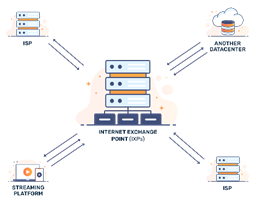‘Regulatory Framework for Promoting Data Economy

Disclaimer: Copyright infringement not intended.
Context
- The Telecom Regulatory Authority of India (TRAI) has released its recommendations on ‘Regulatory Framework for Promoting Data Economy in India.
Background
- National Digital Communications Policy (NDCP) 2018 envisages “Evolving enabling regulatory frameworks and incentives for promoting the establishment of International Data Centres, Content Delivery Networks, and Independent Interconnect exchanges in India”. [DCs, CDNs and IXPs]
- Accordingly, TRAI issued detailed Consultation Paper (CP) on the subject after considering inputs from the stakeholders during consultation process and further analysis of the issues.
- TRAI has finalized these Recommendations to boost to digital infrastructure ecosystem in the country including DCs, CDNs and IXPs.
|
National Digital Communications Policy, 2018 As the present world has entered the era of modern technological advancements in the Telecom Sector such as 5G, loT, M2M etc., a need was being felt to introduce a 'customer focused' and 'application driven' policy for the Indian Telecom Sector, which can form the main pillar of Digital India by addressing emerging opportunities for expanding not only the availability of telecom services but also telecom based services.
Accordingly, the new National Digital Communications Policy - 2018 has been formulated, in place of the existing National Telecom Policy-2012, to cater to the modern needs of the digital communications sector of India.
Objectives The key objectives of the policy are: · Broadband for all; · Creating four million additional jobs in the Digital Communications sector; · Enhancing the contribution of the Digital Communications sector to 8% of India's GDP from ~ 6% in 2017; · Propelling India to the Top 50 Nations in the ICT Development Index of ITU from 134 in 2017; · Enhancing India's contribution to Global Value Chains; and · Ensuring Digital Sovereignty. These objectives were to be achieved by 2022.
Features The policy aims to
Strategy The policy advocates:- · Establishment of a National Digital Grid by creating a National Fibre Authority; · Establishing Common Service Ducts and utility corridors in all new city and highway road projects; · Creating a collaborative institutional mechanism between Centre, States and Local Bodies for Common Rights of Way, standardization of costs and timelines; · Removal of barriers to approvals; and · Facilitating development of Open Access Next Generation Network |
|
Data Center At its simplest, a data center is a physical facility that organizations use to house their critical applic ations and data. A data center's design is based on a network of computing and storage resources that enable the delivery of shared applications and data. The key components of a data center design include routers, switches, firewalls, storage systems, servers, and application-delivery controllers.
CDNs A content delivery network (CDN) refers to a geographically distributed network of proxy servers and their data centers that work together to provide fast delivery of Internet content. A CDN allows for the quick transfer of assets needed for loading Internet content including HTML pages, javascript files, stylesheets, images, and videos. The popularity of CDN services continues to grow, and today the majority of web traffic is served through CDNs, including traffic from major sites like Facebook, Netflix, and Amazon. Internet exchange point (IXP) An Internet exchange point (IXP) is a physical location through which Internet infrastructure companies such as Internet Service Providers (ISPs) and CDNs connect with each other. It's a physical and usually neutral location w here different networks meet to exchange local traffic via a switch. For an IXP to work it needs switches, routers, servers, a neutral location, appropriate power sources, cooling, security, and a technical community of experts to run and manage the IXP.
|
A Must Read:
TRAI: https://www.iasgyan.in/daily-current-affairs/telecom-regulatory-structure-in-india
Telecom Sector: https://www.iasgyan.in/daily-current-affairs/telecom-sector
NIXI: https://www.iasgyan.in/daily-current-affairs/national-internet-exchange-of-india-14
Recommendations of TRAI
A. Data Centres
Facilitating & Incentivizing establishment of Data Centres (DCs) and DC Parks
- Authority has recommended to bring out Data Centre Incentivization Scheme (DCIS)for establishing Data Centres (DCs) and Data Centre Parks (Dc Parks). DCIS to have two list of incentives –
- Certain Centre specific fiscal and non-fiscal incentives and can be rolled out by the Central Government.
- The other in form of a guideline to the States; leaving flexibility to States to announce fiscal incentives through their policies.
Operationalizing a Data Centre specific portal on National Single Window System (NSWS) for -
- Time-bound single window clearances with provision for deemed approval after elapse of prescribed timelines for non-critical category permissions
- Mandatory online registration of new DCs/DC Park operators without any obligation or registration fees. This will be purely for statistical and record purposes.
- Issue of notifications, announcement of schemes & benefits, facility to interact and respond to queries of potential investors, and grievance redressal of existing and prospective DC/DC Park operators.
- A national-level DC Readiness Index (DCRI) frameworkto be implemented by Central Government to rank Indian states as per their suitability to promote DC sector.
- Central Government should prepare guidelines listing out the incentives for the Data Centres and DC Parks for the states. The scheme should, inter-alia, offer incentives in form of land, capital subsidy and Interest subsidy. In such a scheme, while the land may be offered by respective states, the expenses on other offered incentives including capital and interest should have at least 75% contribution from central government.
- Establish DC Economic Zones (DCEZs) - 33 Special Economic Zones have been suggested.
Developing India-specific building norms, standards, and security certification framework
- BIS should be entrusted upon for developing different India-specific building standardfor construction of DCs and to develop India specific standard-based certification framework for the DCs.
- For addressing security aspects of DCs, TEC and STQC should jointly work to develop DC security certification frameworkbased on third party Audits.
Connectivity to Cable Landing Stations (CLS)
- For coastal states intending to promote setting up of new CLS, it has been recommended that they may consider incentives and facilitations of CLSs as has been undertaken by State of Gujarat in its IT/ITeS Policy 2022-27.
- For laying and maintaining OFC infrastructure to CLS, right of way (RoW) charges may be waived off.
|
The RoW is a critical element in the Telecom space and to demystify, RoW is nothing but it gives a guideline to Telecom companies to lay up its infrastructure elements like – towers, optical fiber cables on a designated route. |
Power related
- Telecom Department to take up with Ministry of Power to look into the submissions made by stakeholders for formulation of a DC conducive yet simplified framework for power addressing the issues that have been flagged in the recommendations, inter-alia, including:
- Energy banking provisions for DC/ DC park operators who opt to produce renewal energy for consumption for DC/ DC Parks should be extended to yearly basis.
- Providing land on priority and on concessional rates to DC/ DC park operators for establishing solar power plants.
- DC and DC Park sites should be allowed to operate as backup power infrastructure without any hindrance from state pollution control boards (SPCB) or Central pollution control board (CPCB).
Promoting Green DCs
- Indian Green Building Council (IGBC) along with Telecommunication Engineering Centre (TEC) should be entrusted with task of framing certification standards of green DCsin India.
- Government should form a scheme to invite Requests for Proposal (RFP) on an experimental basis for new technology/methods/processes that can be adopted for promoting green DCs.
Capacity Building
- National Telecom Institute for Policy Research & Training (NTIPRIT) under Department of Telecommunication (DoT), MeitY, All India Council for technical Education (AICTE) and Telecom Sector Skill Council (TSSC) should closely collaborate with DC industry to develop tailor-made short and long-term courses. A suggestive list of DC related courses at diploma, undergraduate and post-graduate level has also been recommended.
Addressing demand side issues of Digital Data Infrastructure –
- Data digitization, sharing and monetization– A statutory body Data Digitization and Monetization Council (DDMC) for steering the data digitization drive be prescribed at the Centre,
- Data Ownership – Government should put in place a data sharing and consent management frameworkon lines of DEPA framework to provide telecom subscribers consent based option to share their KYC data with recipient TSP when they port their numbers.
- Data Ethics –DDMC should also be entrusted with responsibility of putting in place an overarching framework for ethical use of data both by Government as well as by corporate in India. The framework should address the generic as well as vertical sector specific requirements.
B .Content Delivery Networks (CDNs)
- CDNs play an important role in the value chain of content delivery ecosystem. The internet traffic, which was earlier being delivered by ISPs alone, is now being delivered by ISP and CDN combined. ISPs perform load balancing, traffic engineering and offers guaranteed quality of service to end users. CDN Players also leverage various techniques like load balancing, caching, optimization, use of security protocols, etc. for ensuring better delivery of content to end users in association with TSPs. CDN players are major contributors to the network traffic and can affect the overall quality of service. Accordingly, TRAI, in its consultation process, had discussed various CDN-ISP interconnection and collaboration related policy and regulatory concerns. Issues related to challenges for establishing CDN in the country and how CDN Industry can be incentivized, were also discussed.
- To address these issues, TRAI has recommended that CDN players should be registered with DoT through a simple online registration process. The suggestive draft for guidelines for registration of CDN players along with registration form and registration certificate has been recommended with one time registration fee of Rs 10,000.
- The incentives recommended for DCs should also help in proliferation of CDNs in the country and this would in turn provide the boost to digital infrastructure ecosystem, including CDNs and IXPs.
|
ISP An ISP (internet service provider) is a company that provides individuals and organizations access to the internet and other related services. An ISP has the equipment and the telecommunication line access required to have a point of presence on the internet for the geographic area served. |
C. Interconnect Exchanges Providers (IXPs)
- Currently, IXPs are required to obtain Internet Service Providers (ISPs) license which has several onerous licensing conditions related to subscriber verification, security etc which are not relevant to them. This creates artificial entry barriers. To address this issue and promote setting up of more IXPs, especially in Tier-II and Tier-III cities, TRAI has recommended that a separate authorization in Unified License may be created for IXPs with terms and conditions that are much less onerous than ISP license authorization.
- All existing players, including, NIXI should be brought within this licensing framework in a stipulated time not exceeding six months.
- Government should extend the existing list of products under PLI and PPP-PMI schemes to explicitly include classifications of equipment related to CDN and IXP.







1.png)
